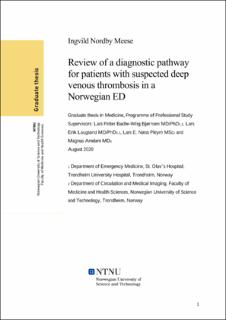| dc.contributor.advisor | Bache-Wiig Bjørnsen, Lars Petter | |
| dc.contributor.advisor | Laugsand , Lars Erik | |
| dc.contributor.advisor | Næss Pleym, Lars E | |
| dc.contributor.advisor | Amdam, Magnus | |
| dc.contributor.author | Nordby Meese, Ingvild | |
| dc.date.accessioned | 2021-09-13T16:15:08Z | |
| dc.date.available | 2021-09-13T16:15:08Z | |
| dc.date.issued | 2020 | |
| dc.identifier | no.ntnu:inspera:60686860:15851511 | |
| dc.identifier.uri | https://hdl.handle.net/11250/2775914 | |
| dc.description.abstract | Introduksjon
Dyp venetrombose er en tilstand med høy insidens I den vestlige verden. Grunnet mangel på et standardisert forløp for pasienter med mistenkt DVT blir de henvist av primærhelsetjenesten som øyeblikkelig hjelp til vurdering i akuttmottaket. De fleste av disse pasientene vil få en lav triageringsgrad, som igjen fører til at de ofte oppholder seg lenge i akuttmottaket før de blir vurdert. St. Olav´s Hospital innførte i mai 2019 et eget diagnostisk forløp med vurdering i en egen akuttpoliklinikk tilhørende akuttmottaket. Formålet med dette forløpet var å redusere liggetid i akuttmottak, forskyve tid for innkomst til tider på døgnet kjent som mindre travel og med dette kunne være et viktig verktøy for å redusere opphopning av pasienter i akuttmottaket.
Metode
Studien er en retrospektiv studie der man har hentet data fra Akuttdatabasen og fra den inhospitale registrering av pasienter i datasystemet PAS, der DVT var en mulig diagnose mellom 1. januar 2018 og 31. desember 2019. Totalt 2415 pasienter ble inkludert i studien. Det ble videre gjort et randomisert utvalg med hjelp av statistikkprogrammet SPSS på 300 pasienter før og etter innføringen av det diagnostiske forløpet, n=150 i 2018 og n=150 i 2019. Dette for å kunne sammenligne både logistiske, demografiske og diagnostiske variabler manuelt i datasystemene.
Resultat
Besøk til akuttmottaket for pasienter henvist med mistenkt DVT økte med 26% fra 2018 til 2019. Fordelingen av alder og kjønn var lignende som i lignende internasjonale studier. 13 (8.7%) pasienter ble diagnostisert med DVT i 2018 og 19 (12.7%), p=0.262. Det var en økning i antall pasienter som kom tilbake for en planlagt kontroll, fra 16 (10.7%) i 2018 til 36 (24.0%) i 2019, p<0.05. Komplikasjonsrate og mortalitetsrate var uendret etter innføring av et eget diagnostisk forløp for denne pasientgruppen. I 2019 ble flere pasienter behandlet poliklinisk sammenlignet med i 2018.
Konklusjon
Implementeringen av et eget diagnostisk forløp i akuttmottaket, ledet av spesialister i akuttmedisin, førte til redusert oppholdstid for pasienter med mistenkt DVT og generelt mindre opphopning av pasienter. Influx av pasienter ble forskjøvet til tider som er mindre ressurskrevende, samtidig som det fremstår både trygt og effektivt. | |
| dc.description.abstract | Introduction
Deep venous thrombosis (DVT) is a condition with high incidence in the Western world. The lack of a standardized pathway for patients with suspected DVT in Norway has led to unnecessary referral of patients to the Emergency Department (ED). St. Olav´s Hospital in Trondheim, Norway, implemented a diagnostic pathway in May 2019. In this new pathway, a hotline for consulting was established between the General practitioners and an experienced emergency physician in the ED. If suspicion of DVT, the patients were examined the following day with ultrasound by an experienced ED physician, and not by a radiologist as during conventional work-up. The aim of this study was to investigate the impact of the diagnostic pathway on the ED length of stay (LOS), patient influx, and ED crowding.
Methods
The retrospective data were collected from a database (Acute ED Database) and included initially all patients with suspected diagnosis of DVT between 1 January 2018 to 31 December 2019 at St. Olav´s Hospital (n=2415). A randomized selection of 300 patients was performed to investigate multiple variables in two patient groups before (n=150) and after (n=150) implementation of the new diagnostic pathway. Information on clinical data including DVT risk stratification tools (Wells score), D-dimer, comorbidity, complications, risk factors, medical treatment, and follow-up appointments was collected manually from electronic patient records (EPR).
Result
Overall, the frequency of ED visits for the patient population increased with 26% from 2018 to 2019 and the frequency of diagnosed DVT patients were similar before and after implantation of the new diagnostic pathway. A total of 13 (8.7%) patients were diagnosed with DVT in 2018 and 19 (12.7%) patients in 2019, p=0.26. LOS was significantly reduced with 23%, (p<0.0001) and patient influx was steered towards before noon. More patients included in the pathway were discharged from the ED (23.3%), but there was an increase in patients returning to the ED for scheduled follow-up (13.3%, p<0.05). The rate of complications (0.7%) and mortality (0.7%) did not increase after implantation of the new diagnostic pathway.
Conclusion
The implementation of a new diagnostic pathway within the ED led by emergency physicians decreased the LOS for patients with suspected DVT and less ED crowding in general. The patient influx was shifted towards less resource demanding periods in the ED and the diagnostic pathway appeared safe and efficient. | |
| dc.language | | |
| dc.publisher | NTNU | |
| dc.title | Review of a diagnostic pathway for patients with suspected deep venous thrombosis in a Norwegian ED | |
| dc.type | Master thesis | |
